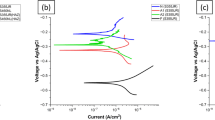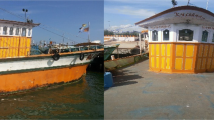Abstract
In seawater environments, naval platform hulls made from high-strength steel plate may be susceptible to pitting corrosion. This form of corrosion can occur as a result of inadequate cathodic protection, coating degradation and the presence of sulphate-reducing bacteria in seawater. Generally, there are two options available when in-service steel plate succumbs to major pitting corrosion. The first option, which forms the basis of this report, is to repair the plate by pad welding. Important considerations for undertaking successful pad-weld repairs include both repair-area dimensions and the weld procedures used. An alternative option to pad-weld repair is to completely or partially replace the plate, which requires careful evaluation of the potential risks to the integrity of the platform. This alternative option is not discussed in detail in the current report. An investigation was undertaken to determine possible limitations on the extent and frequency of pad-weld repairs in order to avoid introducing any adverse effects on the structural integrity of naval platforms. Relevant welding-quality standards, plate-delivery standards, and the general literature were reviewed in order to develop guidelines to ensure that the structural integrity of naval platforms was maintained after pad-weld repairs were carried out. Discussions with experienced welding engineers indicated that the solutions to this investigation could be extracted from the relevant plate-delivery standards. However, it was determined that the maximum allowable repair area (~2–5% of the plate area) in plate-delivery standards is based on economic rationale and customer expectations, which are significantly different from the pad-weld repair of a plate in an existing naval platform. It was concluded that the ultimate decision on the maximum allowable repair area and number of repairs should be based on whether the size or number of repair welds will compromise the mechanical properties of the steel plate and the dimensional stability of the hull. The overarching structural integrity (e.g., residual strength or buckling strength) of the platform could be compromised if the dimensional tolerances of the platform after pad welding were out-of-specification, or if the quality of the pad-weld repairs is in doubt. Pad welding undertaken in accordance with qualified weld procedures (and with qualified welders) will ensure that the mechanical properties of pad welds are within specification. Additionally, the through-life management of pad welds in critical locations should ensure that the integrity of the platform is maintained through-life. This process would mitigate the risk of propagation of hydrogen-assisted cold cracks, stress-corrosion cracks or corrosion fatigue cracks. The likelihood of such defects generally increases as hardness/yield strength increases or when there is cathodic ‘over’ protection. Moreover, it is important to avoid regions of high hardness (or yield strength) in pad-weld repairs. This can be achieved by ensuring that the minimum repair area does not result in the deposition of short (< 75 mm) weld beads.
Similar content being viewed by others
References
Samardzic I., Siewert T.: Reliability improvements in repair welding of high strength steels, MW Doc. IX-2002–01, 2001.
Defence Standard 02-770–1: Requirements for the welding and fabrication of high strength steels: Part 1: General, UK Ministry of Defence, 2005.
Defence Standard 02-770–2: Welding and fabrication of high strength steels: Part 2: Approval of welding procedures for submarine construction and upkeep, UK Ministry of Defence, 2006.
Defence Standard 02–706: Welding and fabrication of ships structure, UK Ministry of Defence, 2000.
Defence Standard 02-826–1: Requirements for Q2 (Navy) quality steel: Part 1: Plates, UK Ministry of Defence, 2000.
US Military Standard 248D (MIL-STD-248D)-1989, Welding and brazing procedure and performance qualification, Department of the Navy Naval Sea Systems Command, 1989, Washington DC 20363–5101.
AS/NZS 3992:1998, Pressure equipment — Welding and brazing qualification, Standards Australia, 1998.
AS 3597:2008, Structural and pressure vessel steel — Quenched and tempered plate, Standards Australia, 2008.
BS EN 10163–1:2004, Delivery requirements for surface condition of hot-rolled steel plates, wide flats and sections — Part 1: General requirements, British Standards, 2004.
BS EN 10163–2:2004, Delivery requirements for surface condition of hot-rolled steel plates, wide flats and sections — Part 2: Plate and wide flats, British Standards, 2004.
Cannon B., Private Communication, Welding Engineer, Bluescope Steel., 2008.
Sterjovski Z., Holdstock R., Carr D.G., Nolan D., Norrish J.: A non-destructive evaluation of transverse hydrogen cracking in high strength flux-cored weld metal, Australasian Welding Journal Research Supplement, 2007, vol. 52, no. 1, pp. 34–40.
Czyryca E.J.: Assessment of Fracture, Fatigue, and Stress Corrosion Resistance of MIL-10718-M Weld Metal, Technical Report NSWCCD-TR-61–97/03, 1997, Naval Surface Warfare Center, Carderock Division, West Bethesda, MD.
ASME IX:2007, Boiler and pressure vessel code, Welding and Brazing qualification, 2007.
Welding and fabrication of quenched and tempered steel, Technical Note 15, 1996, Welding Technology Institute of Australia (WTIA).
Author information
Authors and Affiliations
Corresponding author
Rights and permissions
About this article
Cite this article
Sterjovski, Z. Pad-Weld Repairs of in-Service High-Strength Steel Plate used in Seawater Environments. Weld World 54, R173–R181 (2010). https://doi.org/10.1007/BF03263503
Published:
Issue Date:
DOI: https://doi.org/10.1007/BF03263503




